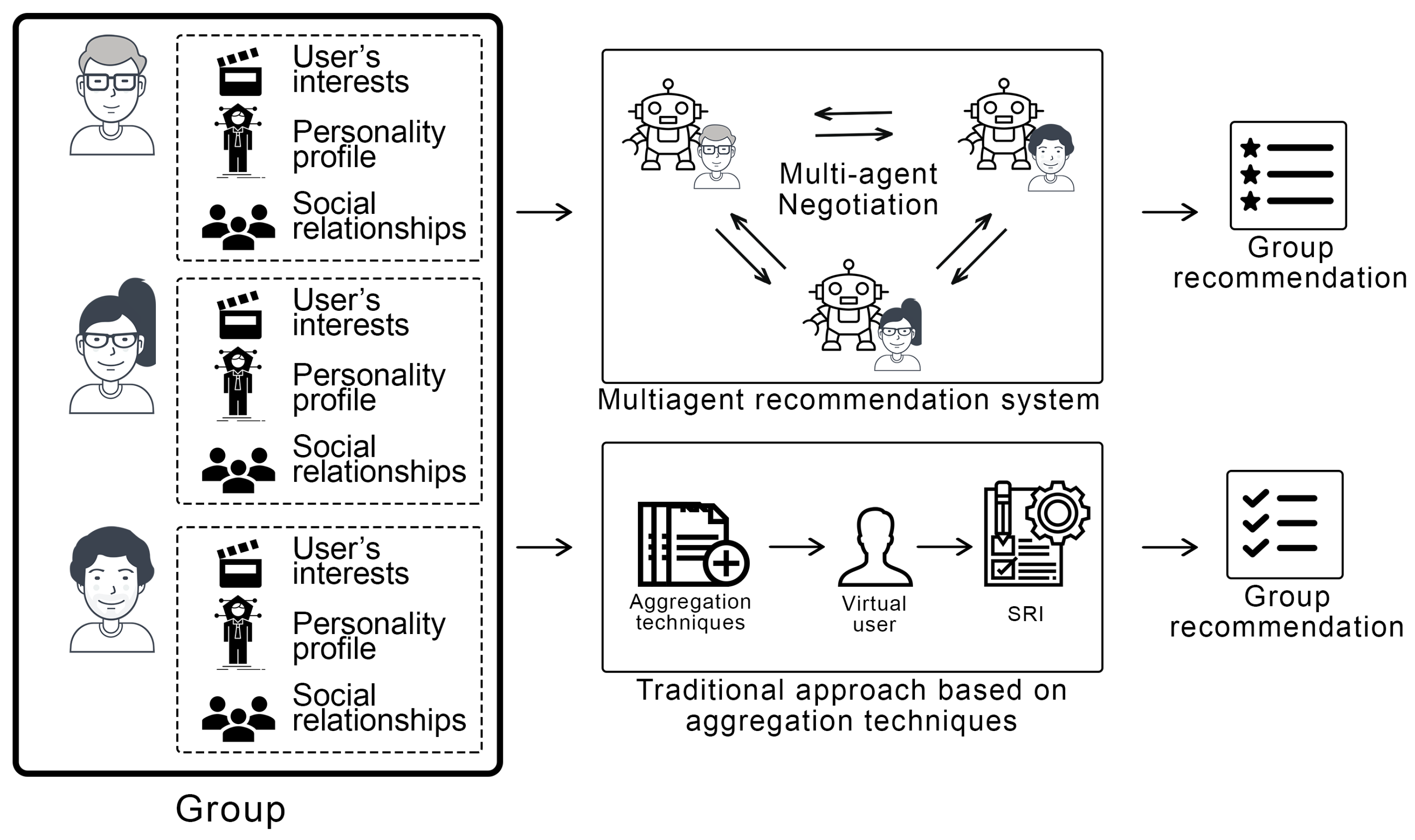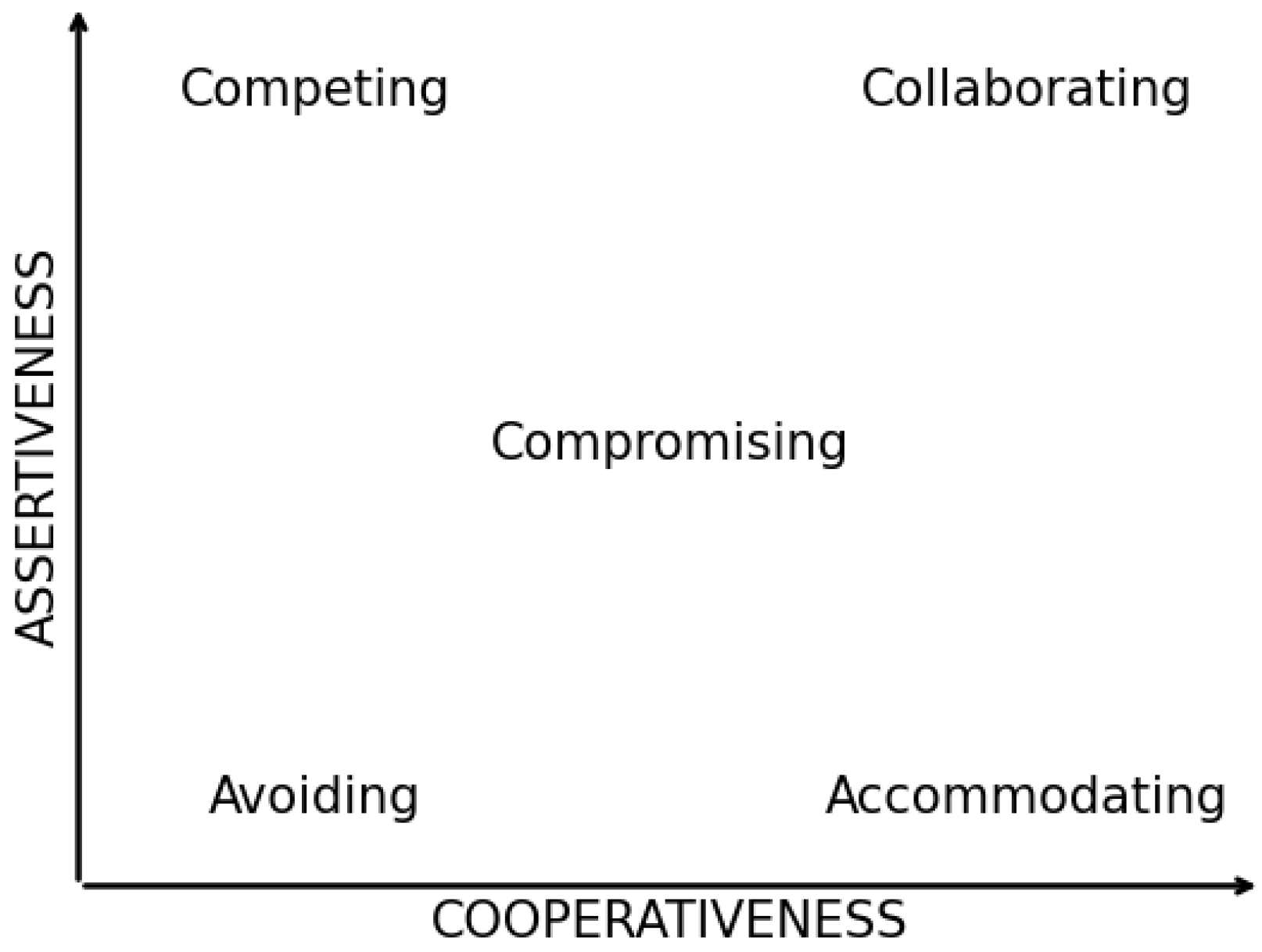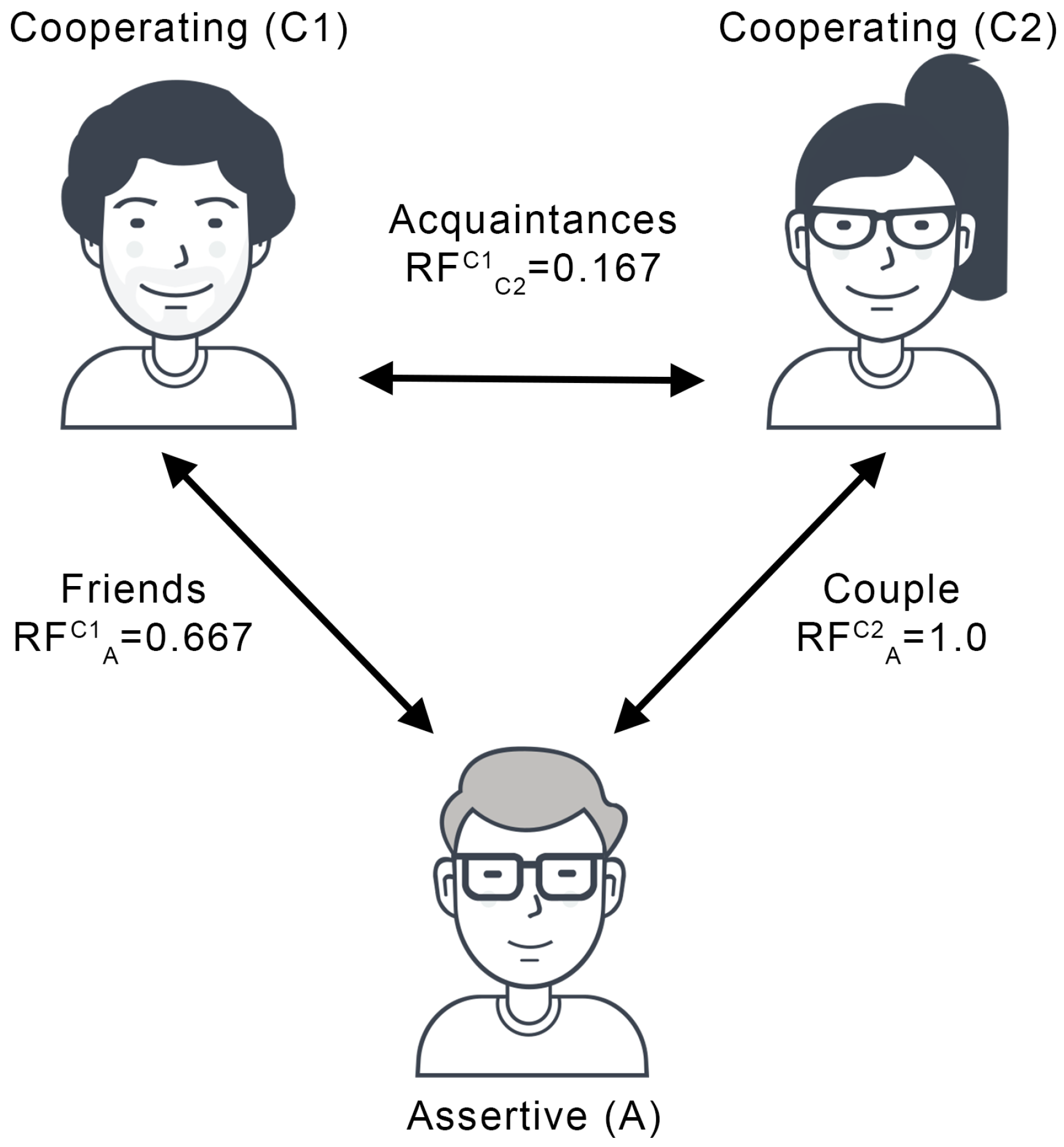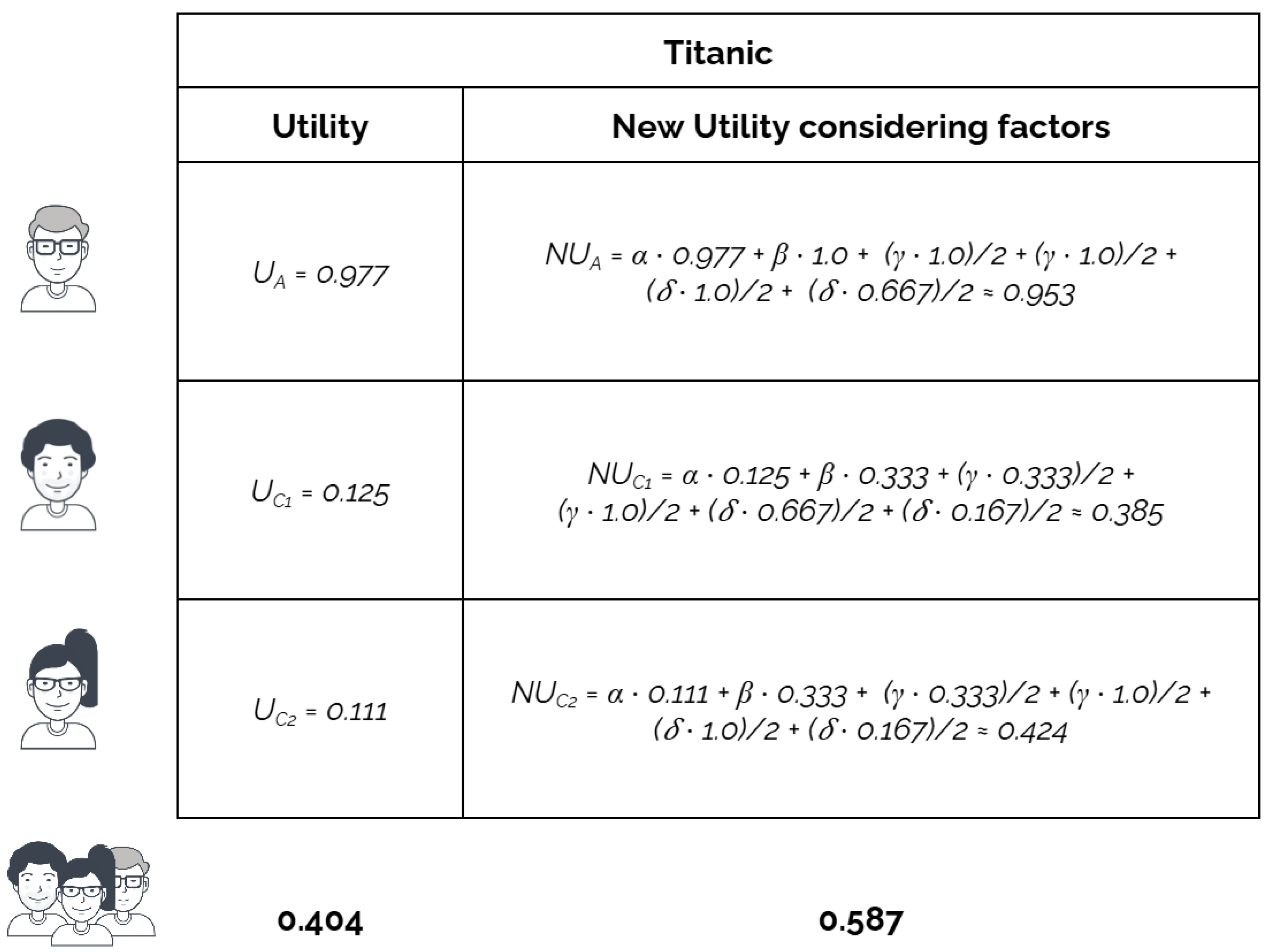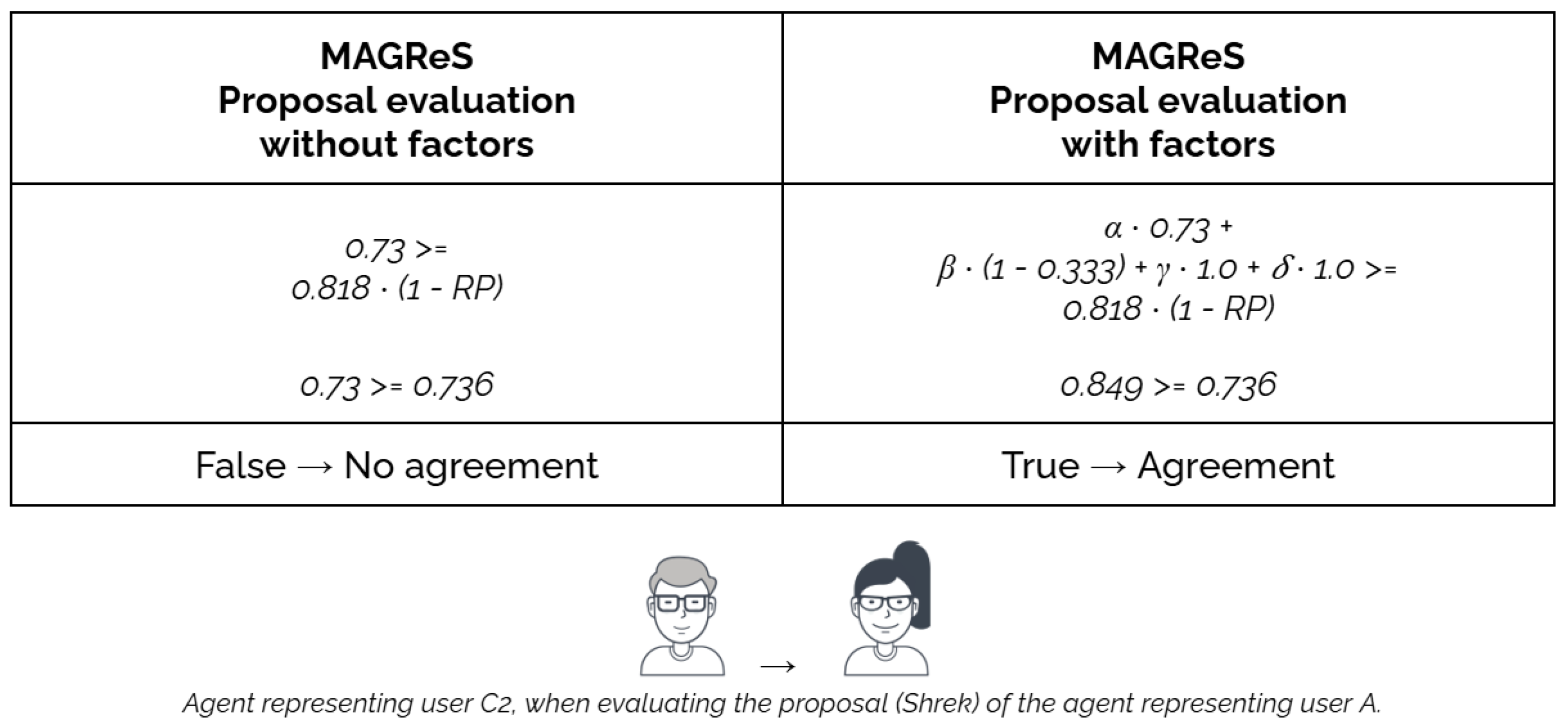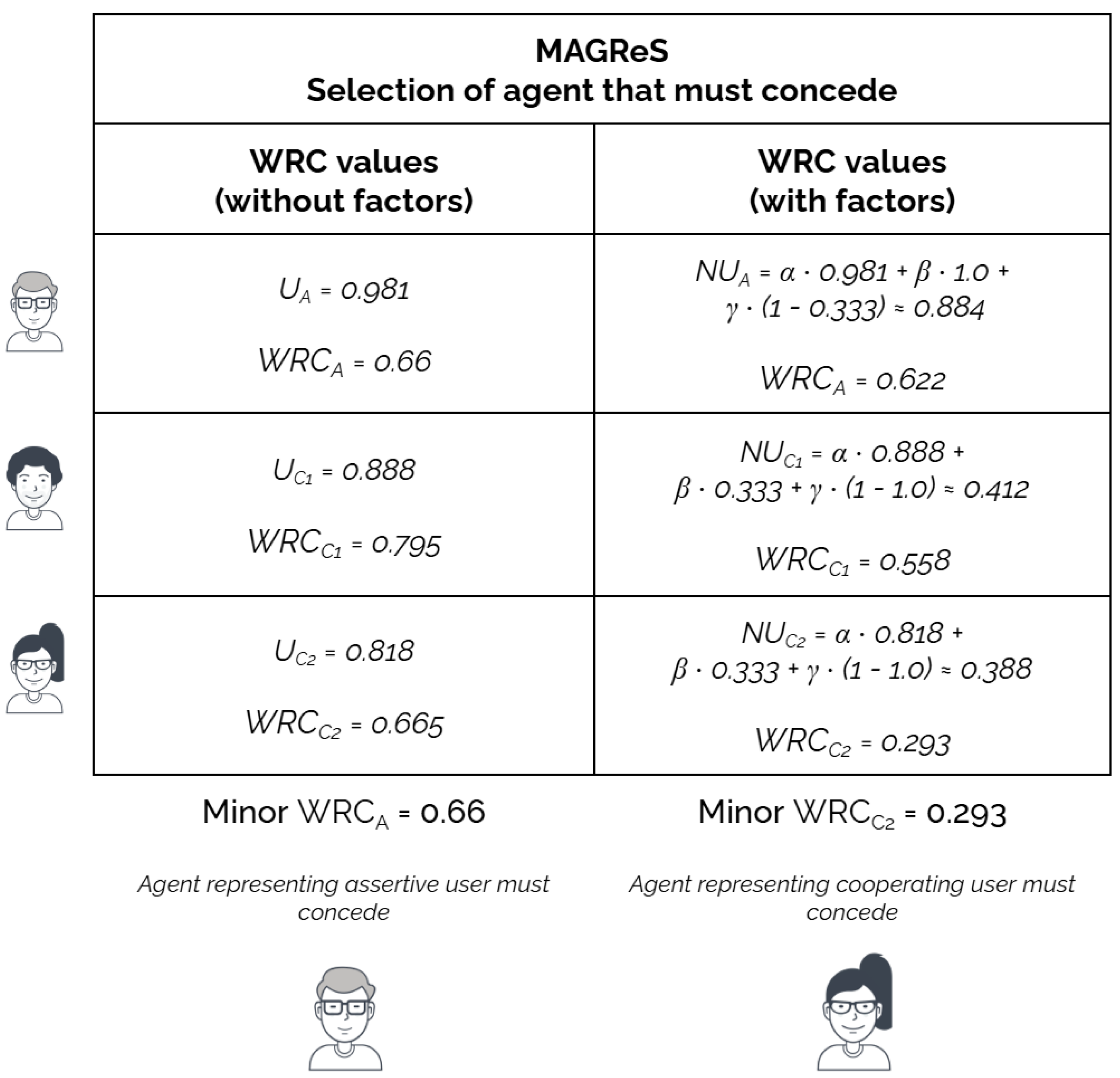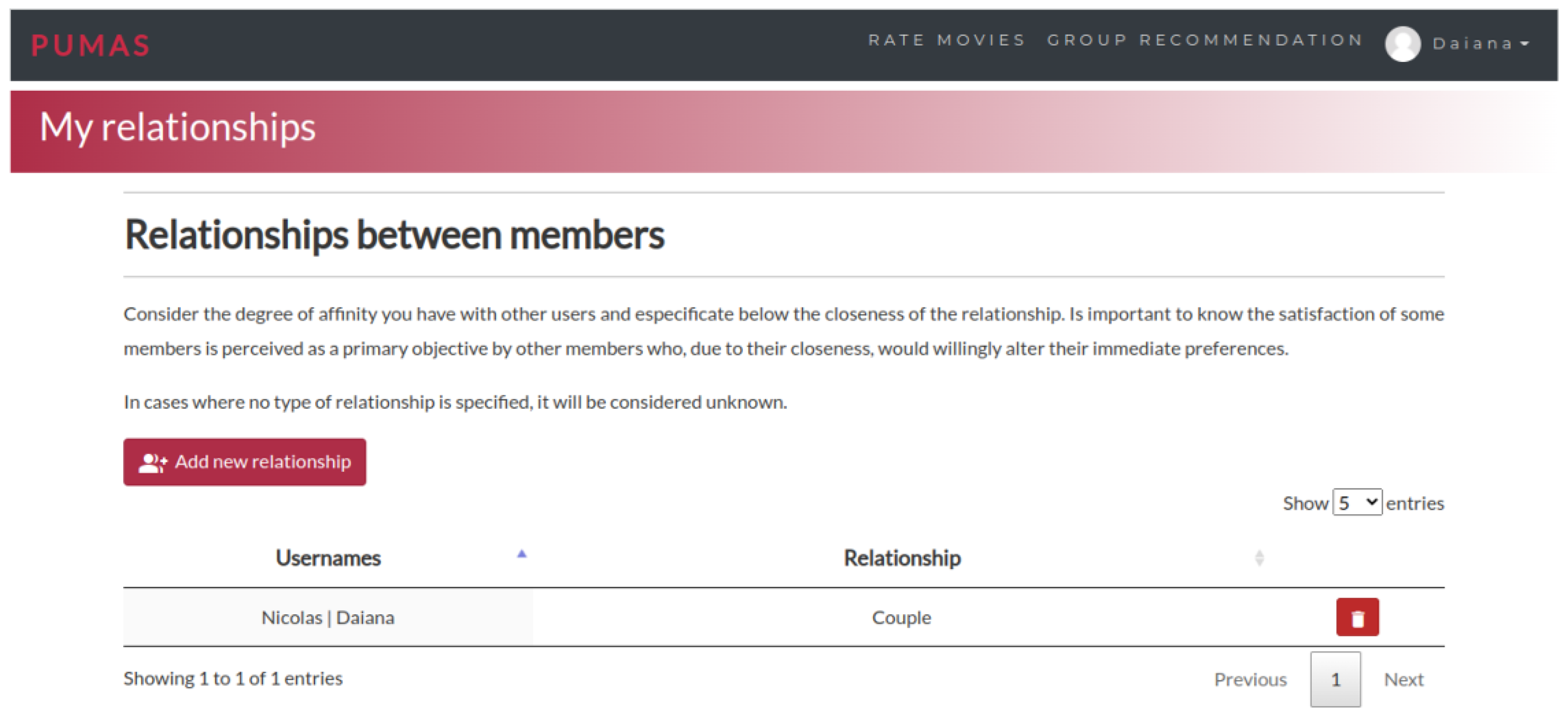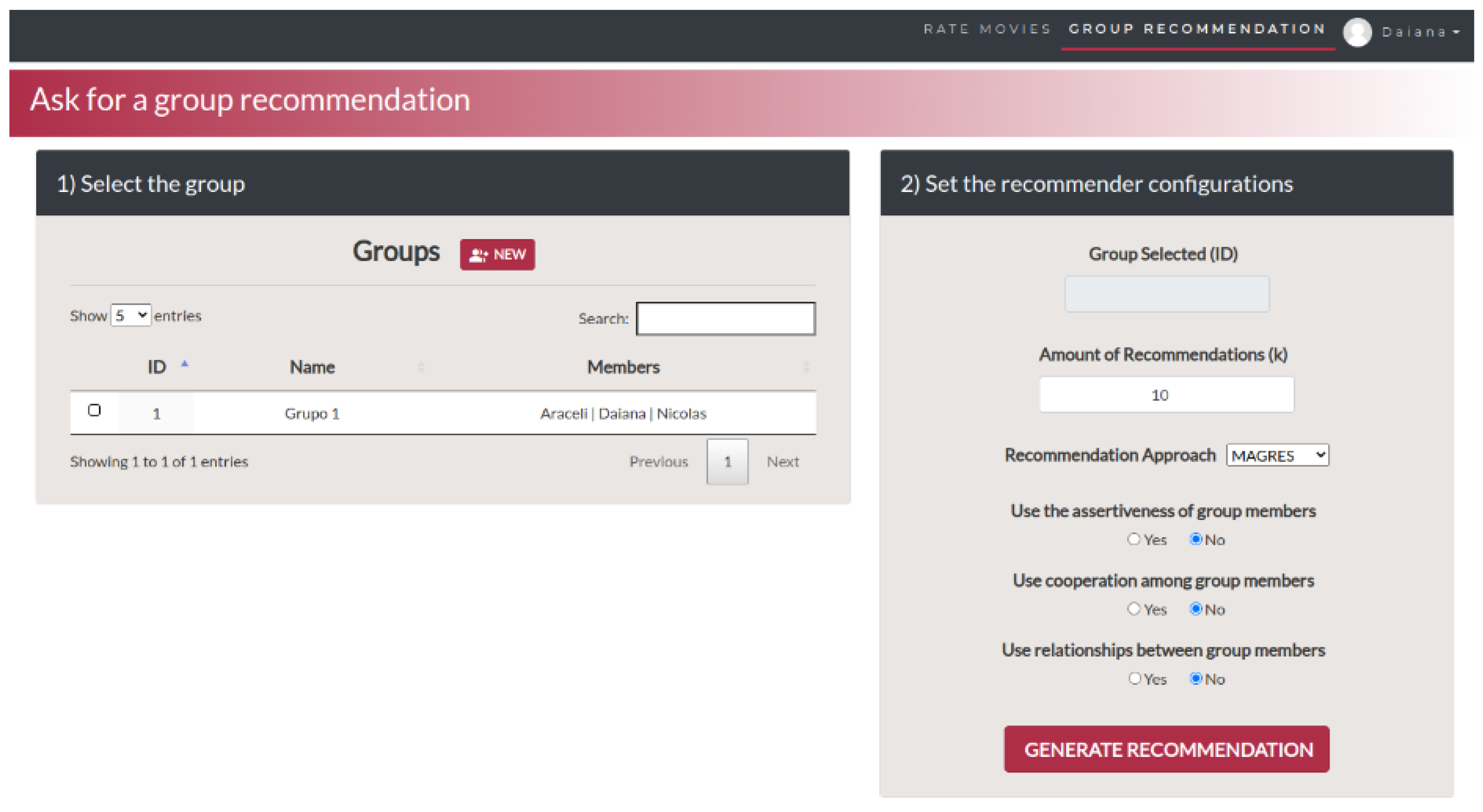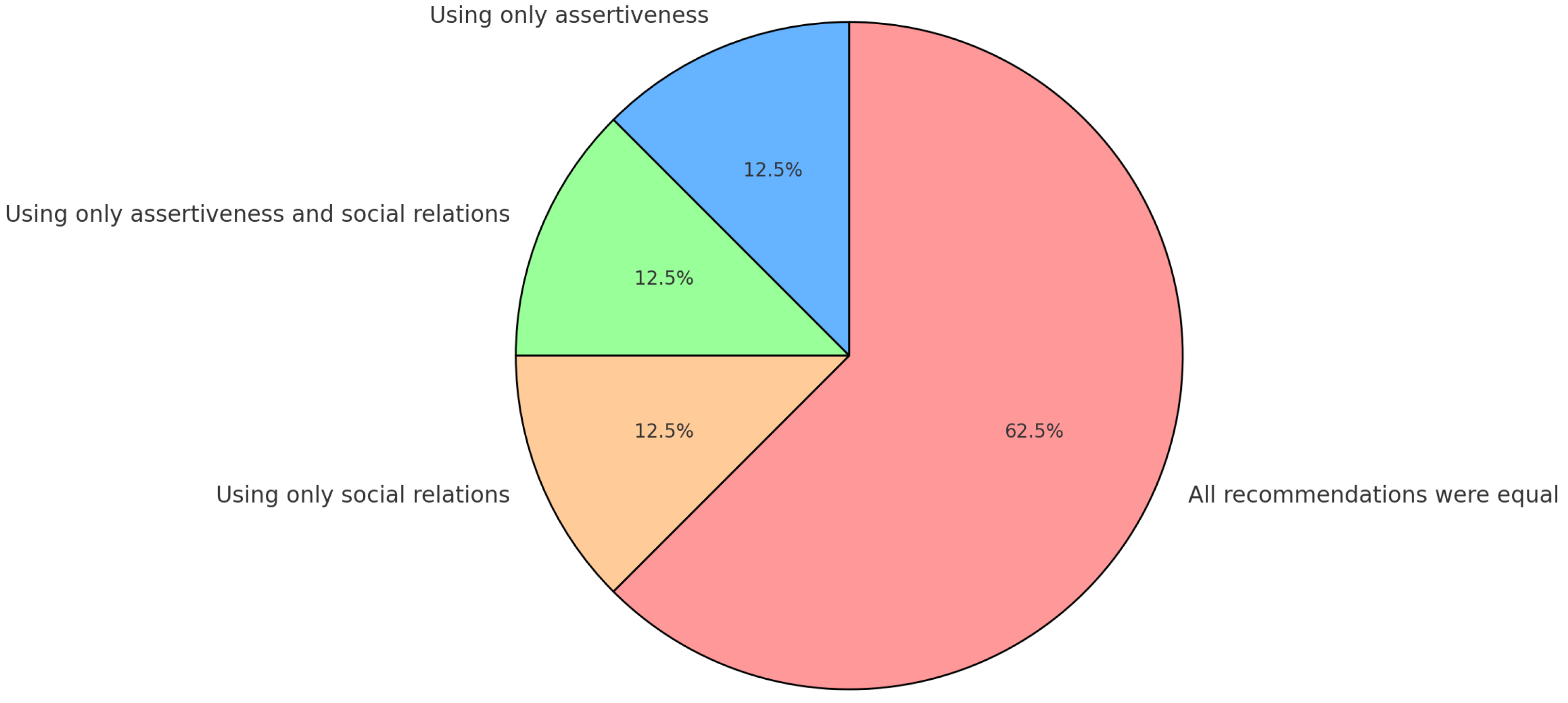1. Introduction
Recommender systems (RS) have traditionally been a promising research area, not only because of their ability to handle the problem of information overload but also because of the huge number of applications that use them, particularly in marketing and e-commerce [
1,
2]. Initially, RS were used to make recommendations of potentially interesting items to individuals. Later, the same ideas were applied to make recommendations to groups of people, which sometimes share the same goals, resulting in Group Recommender Systems (GRS) [
3].
The most widely used group recommendation approaches are based on traditional aggregation techniques, such as average and minimizing misery, which can result in poor recommendations due to the nature of the calculations [
4]. However, making recommendations to groups of users involves several challenges, including the existence of conflicting interests among group members and the unique decision-making dynamics of each group (such as influences of some users on others). Thus, we consider that an approach that goes beyond traditional aggregation techniques and that takes into account users’ personalities and relationships is needed. Multi-agent systems (MAS) are an alternative solution to address these issues [
5]. A MAS is a distributed system of multiple intelligent agents that interact with each other and are capable of achieving goals that might be impossible to achieve by individual agents. Several works have proposed the use of MAS for group recommendation [
6,
7,
8,
9]. However, although most succeed in capturing the dynamics of interaction between group members, they fail to consider personality traits and relationships among users. Particularly, we base our work in MAGReS (Multi-agent Group Recommender System) [
10]. In that work, during the generation of recommendations using MAS, each user is represented by an intelligent agent. These agents negotiate among them to reach consensus on what item should be recommended to the group. In MAGReS the negotiation is achieved by using MCP (Monotonic Concession Protocol) [
11], which mimics human negotiation process. In this context, it is vital to model users as faithfully as possible to obtain more accurate recommendations.
For this reason, in this work, we propose taking into account personality traits and relationships between users within the negotiation process used to generate group recommendation. Specifically, five personality ways of dealing with conflicts (the Thomas-Kilmann theory [
12]) and social relationships between group members are incorporated to quantify the degree of influence based on the level of trust, friendship, or affinity among members. The challenge of generating recommendations for groups of individuals lies in the heterogeneity of their members and the diversity of their interests and preferences. The proposed approach aims to address these issues. Moreover, since multi-agent recommender systems focus on more closely resembling group dynamics, it is important to incorporate personality aspects (particularly, conflict management styles) and social relationships into them.
To take into account user relationships, we propose to give different weights to different types of relationship (e.g., couples have more affinity than family relationships, and family relatives have more affinity than workmates) [
13]. To model the level of cooperativeness or empathy of users, as well as their capacity to influence other users, we propose to use Thomas-Kilmann Management Model. This model defines 5 personality types in the context of conflict management. It is a test designed to measure people’s behavior in different situations along two dimensions: assertiveness and cooperativeness [
12]. The idea of including this model in the group recommendation process is that assertive persons penalize differences between their own preferences with the best choices of others, because these other options do not satisfy their own interests. However, cooperative persons acknowledge others’ points of view and take the time to agree [
14]. Thus, we propose an extension to the MAGReS negotiation model to include users’ relationships and users’ personalities according to the Thomas-Kilmann model.
In order to evaluate the proposed approach, we have included the new user representation in both MAGReS and traditional aggregation approaches. To carry out the experiments, we have developed a movie recommender system, and evaluated it with real users.
The main contributions of this work are:
We propose a MAS-based approach that incorporates different ways of dealing with conflicts into the negotiation process, using the Thomas-Kilmann model.
The approach also integrates different types of social relationships between users into the negotiation process.
We present experimental results obtained with real users that show the importance of considering these factors to generate more accurate recommendations for the group.
The rest of the article is organized as follows. In
Section 2 we analyze some related works. In
Section 3 we present our proposed approach. To do this, we show how to capture users’ individual interests, personality traits, and social relationships. Then, we explain how these factors are incorporated to a traditional aggregation approach and a multi-agent approach for group recommendation.
Section 4 presents the experimental evaluation and the results we obtained. Finally, in
Section 5 we discuss the results, limitations, and future research directions of the proposed approach.
2. Related Work
Group recommendations emerged in the recommender systems area during the last two decades [
15]. GRS can be classified considering the approach to make recommendations into three main categories:
preference aggregation [
16] systems, which merge individual preferences or ratings to obtain a group evaluation for each candidate item;
recommendation aggregation [
17] systems, which first make individual recommendations for each member and then merge those recommendations;
model or profile aggregation [
18] systems, which first merge users’ models into a single group model and then generate suggestions based on that model.
There are several techniques for aggregating data, and their suitability depends on the data being aggregated and the goal being pursued by the system. For example, Masthoff [
19] analyzed different techniques for merging individual recommendations such as average, average without misery, most pleasure, and least misery, among others. Similarly, in [
17], the authors analyzed the effectiveness of ranked list recommendations tailored to a group of users using different methods such as: Spearman rule, Borda count, average and least misery.
In addition, other approaches have been considered for group recommendations. Our work relies on MAS. When it comes to MAS applied to GRS, only a few works have been reported, most of them in the tourism domain. In [
20], the authors present a GRS that relies on the application of cooperative agent-based negotiation to make recommendations for tourists. One of the drawbacks of this approach is that it has only been tested with simulations involving two agents (a group of two users). In [
21] its is proposed an agent-based negotiation approach that uses alternating offers, in which the agents representing a group member negotiate the preferences of the whole group. This approach is suitable for every domain, provided that the domain can be represented using ontologies.
A related research area is group decision making (GDM), which consists of a group of people who express their opinions on a set of alternatives with the aim of choosing the best one for the group. When these people are related and are part of a social network, then a new kind of group decision arises: social group decision making (SGDM). A key aspect in this context is the consensus reaching process (CRP). CRP has been well studied and various consensus approaches have been developed. For surveys on works in these topics the reader can consult [
22,
23]. An analysis of different aggregator operators in the context of GDM is presented in [
24].
We have focused on analyzing several works on GRS that include personality profiles, social relationships, negotiation, or similar aspects for generating recommendations. We have summarized their main characteristics in
Table 1. This table does not intend to be exhaustive, but to present the most relevant works in the area in the last years. The following aspects are considered:
Personality profile: If the approach takes into account the personality traits of the group members.
Emotions: If the research includes affective features such as anger, disgust, fear, happiness, sadness, or surprise.
Social relationships: If the work examines in some way the level of trust among group members, either implicitly through inference of behavior on social networks or explicitly by specifying the type of relationship or degree of friendship.
Similar profiles: If the research includes the study of similarity between the preferences of group members.
Social influence: If the work studies influential people who might affect the decisions of other group members, either because they have a certain degree of persuasion, or because others are prone to change their attitude.
Past recommendations: If the approach takes into account previous recommendations to improve results.
Multilateral negotiation: If the research not only includes traditional preference aggregation but also simulates the negotiation process by considering multilateral agreements and concessions.
As we can observe, various approaches have addressed the problem of making group recommendations. Although some of them even include negotiation in the context of MAS, the protocols used are different. For example, [
21] uses an extension of a bilateral negotiation protocol, and [
9] utilizes negotiation with an agent that monitors the behavior of every negotiation agent. None of the works we have analyzed includes personality information as part of the negotiation process.
In [
8], the authors propose a negotiation protocol that considers trust and distrust factors between users. However, these factors are determined by comparing user ratings for common items (if users have similar preferences then trust increases, but if their preferences diverge distrust grows). This method is similar to collaborative filtering, since both are based on previous interactions of users with the same items, and do not consider relationships between users outside the evaluated items.
3. Materials and Methods
Our work is based on the MAGReS approach, which generates recommendations for groups using negotiation among intelligent agents. In that approach, each agent represents a member of the group that is going to receive the recommendation. We propose to incorporate the personality of these users and the degree of trust or affinity determined by the type of pre-existing relationship between the members into the negotiation process. Thus, we evaluate how these factors affect recommendation generation for the group.
Section 3.1 presents an overview of the approach.
Section 3.2 describes how we acquire information about the group members to build user profiles. Then,
Section 3.3 describes how these profiles are included in the aggregation approach, and
Section 3.4 describes how they are merged into the MAS-based approach.
3.1. Overview of the Approach
Figure 1 shows an overview of the proposed approach. First, information on the preferences of group members must be obtained, capturing the individual interests of each user to create customized profiles. Each preference profile is established based in the evaluation of a certain number of items that allow determining the user’s interests. In addition, the personality profile of each user is determined based on the result of the Thomas-Kilmann questionnaire [
12], which allows to know the level of assertiveness and cooperativeness of each group member. Finally, to determine the level of trust or affinity degree between users, each member must explicitly specify the type of existing relationship, each of which has an assigned weight that represents the level of trust with the other person. All this information constitutes the user profile, which will be used to generate the recommendations for the group.
As observed in
Figure 1, the generation of the recommendation can be carried out with the traditional preference aggregation approach and with the MAGReS approach. This will enable us to compare the different approaches. In the first case, preference aggregation allows the creation of a virtual user that incorporates the assertiveness factor, cooperativeness factor, and levels of trust mentioned previously.
Section 3.3 shows how these factors are incorporated during the aggregation process that creates the virtual user. In the second case, the MAGReS approach consists of a negotiation process that guides the intelligent agent toward multilateral agreements through the proposal exchanges and concessions. In this work, intelligent agents incorporate the assertiveness and cooperativeness factors of each group member they represent, as well as the relationship factors within the group.
Section 3.4 shows how these factors are integrated into the evaluation of the proposals and used to determine which user must concede during the negotiation process.
3.2. Capturing Individual Interests
In order to build user profiles, we need to obtain information about the preferences of group members, i.e., capture the individual interests of each user. The most commonly used technique, and the one that more accurately represents the interests of individuals, is to obtain this information explicitly. In a recommender system, we need the ratings for the items already consumed by each user, for example, movies watched. Additionally, we require users to answer the Thomas-Kilmann questionnaire using the TKI instrument to determine users’ assertiveness and cooperativeness levels. Finally, we have to compute the degree of affinity or trust level between group members.
3.2.1. User Personality
The TKI test developed by Kenneth W. Thomas and Ralph H. Kilmann in the early 1970s [
12], was based on the managerial conflict style model proposed by Robert Blake and Jane Mouton [
34]. The instrument is specifically designed to assess an individual’s behavior in situations of conflict, which are characterized by apparent incompatibility between the concerns of two individuals. As shown in
Figure 2, in these conflict situations, an individual’s behavior can be characterized using two dimensions: (1) assertiveness, which reflects the degree to which the person seeks to fulfill their own concerns, and (2) cooperativeness, which indicates the extent to which the person attempts to satisfy the concerns of the other person. A competing individual is assertive but uncooperative, prioritizing their own concerns at the expense of others. In contrast, an accommodating person is unassertive yet cooperative, acting as the complete opposite of competing. When accommodating, the individual prioritizes the concerns of others over their own, often to the point of self-sacrifice. An avoiding individual is both unassertive and uncooperative, refraining from addressing either their own concerns or those of others, effectively sidestepping the conflict entirely. Collaborating, on the other hand, is both assertive and cooperative, representing the opposite of avoiding. This approach involves actively working with others to develop a solution that fully satisfies everyone’s concerns. Finally, a compromising individual strikes a balance between assertiveness and cooperativeness, seeking a practical, mutually acceptable solution that partially satisfies both parties. This style lies between the extremes of competing and accommodating.
The instrument consists of a questionnaire with thirty different situations, with two possible responses for each one, which can be answered in approximately 15 min. Each of the options corresponds to the attitude that one of the five personality profiles proposed by the Thomas-Kilmann conflict handling mode would take. Thus, in a given conflict situation, the users have the possibility to identify themselves as competing, collaborating, compromising, avoiding or accommodating, as appropriate. The user must choose the option that is most characteristic of her own behavior or the most likely attitude towards that situation.
3.2.2. Social Relationships and Social Influence
To determine the level of trust or degree of affinity between two users, we considered the proposal of [
13]. In that work, it is proposed that each individual must explicitly specify the type of relationship she maintains with other users in the system, with whom she could eventually form groups. In this way, each type of relationship has an assigned weight, which represents the level of trust with the other person, by utilizing a simple discretization technique in which the closest relationship (couple) receives the highest weight. These weights, shown in
Table 2, have been experimentally evaluated by the authors through an experiment with 198 real users in the movie domain. It is important to mention that other alternatives could be applied to compute these weights. For instance, requesting users to explicitly indicate their level of trust for each individual or predicting trust levels based on previous interactions. Compared to the selected approach, these alternatives demand greater effort from the user or rely on information from previous interactions, which may not always be available.
3.3. Aggregation Approach
TRADGRec is the approach used to generate group recommendations based on aggregation techniques. It follows the guidelines proposed in most of the GRS literature [
3,
35]: to generate a group recommendation, first build the group preference list, then create a virtual user that represents the group and assign the created preference list to it, then add the virtual user to the data model of an individual recommender system (IRS) and, finally, use an IRS to generate a recommendation for the virtual user representing the group. The application we implemented allows us to configure, and therefore to choose, the aggregation strategy to use. The strategy can be: averaging, least misery, most pleasure, plurality voting, and upward leveling.
To incorporate the factors of assertiveness, cooperativeness, and the relationship factor between the members of the group into the aggregation approaches, we modified the group preferences building process. Instead of using the user’s utility for a certain item, whether based on explicit rating or utility estimation, we use the new utility expressed in Equation (
1).
This Equation is a weighted formula where: is the item to evaluate; is user u’s utility for item ; is the weight for the standard utility; is user u’s factor of assertiveness; is the weight for the factor of assertiveness; G represents the set of users that are part of the group; is user v’s factor of cooperativeness; is the weight for the factor of cooperativeness; is user v’s relationship factor between user u and v. Here, . Notice that the way in which is computed does not affect that formula.
For example, considering the group shown in
Figure 3, where three users want to watch a movie, two users (
and
) are cooperative, and the other (
A) is assertive. Regarding relationships,
and
are acquaintances,
A and
are a couple, while
A and
are friends. Consider, for example, the movie Titanic,
Figure 4 shows the different utility values with and without considering the new factors for the different users and for the group, where
. We can observe that the group utility (average of individual utilities) is greater when considering factors (0.587) than when factors are not considered (0.404). As can be observed, the movie Titanic has a very high utility value for the assertive user, while it has very low utility values for the cooperative users. Using the traditional aggregation of preferences and averaging the utility values of the three participants, an aggregate utility value of 0.404 is obtained. However, incorporating factors such as assertiveness, cooperativeness, and social relationships, new utility values are generated, yielding a higher average value of 0.587. This shows that when using the new utility values, taking into account assertiveness, cooperativeness, and social relationship factors, a higher average is obtained compared to the calculation without these factors. This outcome is due to the preference of the assertive user being favored, assigning greater weight to the movie Titanic.
3.4. MAGReS Approach
Providing recommendations to groups of users has become a promising area of research, as many items tend to be consumed by groups of people. However, satisfying all group members uniformly remains a challenge. Most traditional approaches make use of aggregation techniques [
2,
36]. Although they are widely used in many domains, the limitations of aggregation techniques mean that, in many cases, the generated recommendations fail at satisfying all group members uniformly. In addition, many of these aggregation techniques do not allow modeling aspects linked to the decision-making processes of the groups or the characteristics of each individual, which reduces the level of personalization of the generated recommendation. Around this idea arises MAGReS, an approach to generate group recommendations using MAS [
10,
37] depicted in
Figure 5.
MAGReS contains three main modules that interact with each other to generate group recommendations: Negotiation Module, Recommendation Generation Module, and Explanation Generation Module. The Negotiation Module selects the items that will be recommended to the group (2). To carry out this task, this module uses a MAS where each member of the group is represented by an agent who knows their preferences and participates in a negotiation process in which they decide which item to recommend to the group. The agents are homogeneous (sharing the same internal implementation but representing different users) and competitive (inherent to the nature of negotiating agents). Negotiation is carried out according to the Monotonic Concession Protocol (MCP) [
11], which was chosen because it mimics the way the negotiation process with humans works [
10]. In MAGReS, this protocol was extended to increase the level of customization of agents, so that each user can have greater control over how they want the agent to behave in the negotiation. This, in turn, helps each agent better represent its user. As a result of the negotiation process, this module produces two outputs: (i) the item selected to be recommended (if one could be selected) and (ii) a record of negotiation events.
The Recommendation Generation Module is responsible for generating group recommendations, invoking the negotiation module, which informs about the user’s interests and the behavioral configurations that the user chose (implicitly or explicitly) for their agent (1). Every time the negotiation module selects an item, the recommendation module adds it to the list of items that will be recommended (3). Subsequently, the list of recommendations is ordered and prepared to be presented to users (5). This module is also responsible for generating indicators that contain information regarding the recommendation generation process (for example, estimates of satisfaction levels and negotiation data, among others).
The Explanation Generation Module is responsible for generating explanations, which are generated by applying a set of rules on the data contained in the indicators generated by the recommendation generation module (4). Currently, this module allows to generate explanations related to the estimated satisfaction levels of the group and its members, both with respect to each recommended item and the recommendation (list of items), the affinity between the interests of the group members, and specific eventualities that may have occurred during the recommendation process and must be notified to the group (6).
Figure 6 presents the MCP communication protocol using FIPA-ACL performatives [
38]. To facilitate readability, we present the protocol for two agents; in the multilateral case, all messages are distributed among all group members. There are two very important points that must be highlighted in the MCP implemented by MAGReS: (i) the moment where the proposal is evaluated and it must be decided whether the group members accept or reject the proposal; and (ii) the moment where it is decided who should concede based on the concession strategy. The next subsections explain how these points are affected in order to consider personality and relationship factors.
3.4.1. Proposal Evaluation
The MCP protocol determines that an agreement has been reached if an agent makes a proposal that is at least as good for the other agents as its own current proposals. Thus, given two users
u and
v, if the user
u’s utility of the user
v’s proposal is greater than or equal to the user
u’s utility of the user
u’s own proposal, then user
u accepts user
v’s proposal. In MAGReS, this proposal acceptance strategy is named ‘Strict’. Taking into account this definition, we define the proposal evaluation condition by following the Equation (
2) to include the personality profile of user
u and the social relationship between user
u and user
v were
.
This formula changes the evaluation that user u makes of the proposal received from user v by considering: the standard utility of the proposal (), user u’s assertiveness and cooperativeness factors ( and ) and her relationship with user v (). Also, here, . Note that the formula considers to negatively represent the emphasis on user u’s own needs.
It is important to mention that in MAGReS different proposal acceptance strategies are defined:
Strict: This is the criterion in which a user accepts a proposal if it is at least as good in terms of utility as their own proposal [
11]. As mentioned above, this strategy follows the Equation (
2).
Relaxed: A user accepts a proposal if it is as good as their own proposal or at least close to it. This strategy uses a relaxation percentage to lower the utility value of her own proposal, thus giving more weight to the utility of the other user’s proposal. Here, the right side of the Equation (
2) is replaced by
, where
is the relaxation percentage.
Next: In this case, a user accepts a proposal if it is as good as her current proposal or at least better than her next proposal, i.e., the one she will make if she needs to concede in the next round. Here, the right side of Equation (
2) is replaced by
, where
is the user
u’s next proposal.
In each of these acceptance strategies, the utility comparison formula can be applied considering social relationships and personality profiles. Thus, strategies affect the utility term for the user’s own proposal, while assertiveness, cooperativeness, and relationship factors affect the utility term for the other user’s proposal.
Figure 7 shows an example of a proposal evaluation with and without factors using the relaxed proposal acceptance strategy with
. In this figure, the agent representing user
evaluates a proposal (Shrek) made by the agent representing user
A.
3.4.2. Selection of Conceding User
When the agents do not reach an agreement (i.e., at least one agent rejected the latest proposal) in a round of the negotiation, it is necessary to determine which agent(s) should make a concession. Although there are different types of concession strategies, in this work we used a traditional one that has shown the best results: the Willingness to Risk Conflict strategy. This applies the Zeuthen strategy [
39] around the concept of willingness to risk conflict (
). In this strategy, the loss of utility in case of concession is evaluated assuming the worst possible result for the user [
40]. The
for agent
representing user
u (
) is then given by Equation (
3).
where
represents the utility that agent
assigns to the item it proposed,
is its most recent proposal, and
is the utility that agent
assigns to the item that agent
proposed (
). After calculating the
for each agent, the protocol requires the agent(s) with the lowest
value to make a concession. To take into account the factors of assertiveness, cooperativeness, and social relationships during the selection of the conceding user, the utility function applied to the most recent proposal made by the user is adjusted. Thus, we replace
with
according to Equation (
4).
This equation is also a weighted formula where:
is the item to evaluate;
is user
u’s utility for item
;
is the weight for the standard utility;
is user
u’s factor of assertiveness;
is the weight for the factor of assertiveness;
is user
u’s factor of cooperativeness; and
is the weight for the factor of cooperativeness. Here,
. In
Figure 8, we present an example of the selection of conceding user using the Willingness to Risk Conflict strategy. It can be observed that at the beginning the lowest
value is the one calculated for agent
, thus, it is expected that he should be the one who should concede. However, using the approach that includes the assertiveness and cooperativeness factors, the results for the
values are different. With the factors, the lowest
value is for agent
representing a cooperative user. It is evident that when using the personality profiles, the
values are altered, emphasizing the needs of the assertive user and, consequently, favoring the group. In this context, the assertive agent naturally becomes less likely to be the one making concessions, giving priority to his preferences.
4. Experimental Evaluation
In this section, we present the experimental evaluation conducted with real users in the domain of movie recommendation. In the next subsections, we introduce the movie recommendation application used to conduct the experiment, the experimental setting, and the obtained results.
4.1. Movie Recommendation Application
In order to evaluate the proposed approach, we have developed a movie recommendation application for groups of users. This application uses the Mahout framework as individual recommender and the users and movies provided by the well-known MovieLens dataset [
41]. A snapshot of this recommender system is shown in
Figure 9. To obtain users’ preferences, users are required to rate a set of movies when entering into the system for the first time. In order to obtain users’ personalities regarding conflict management, users are requested to complete a questionnaire. Then, the system computes users’ personalities according to the TKI instrument, and it presents the results to users as shown in
Figure 10. Then, users are requested to explicitly indicate their relationships with other users.
The movie recommendation system has a screen that allows users to configure certain parameters when generating recommendations for groups. In the top bar, as it can be seen in
Figure 11, a button with the text ‘Group Recommendation’ allows us to display the screen to select these options: the group to which they want to make the recommendation for; the number of recommendations (
k) required; the approach to use, which can be TRADGRec or MAGReS; and whether to use the level of assertiveness and/or the level of cooperativeness of the group members or not, and/or use the social relationships between them or not.
4.2. Experimental Setting
We conducted an experiment with 24 real users, 8 women and 16 men. The personality profile of each user is made up of a percentage that corresponds to each of the five personality modes when dealing with conflicts. However, if we take the predominant profile of each of them, we can say that the majority of people who volunteer for the experiments have an accommodating profile (35.4%); then, we can find avoiding users (26.4%), and in a less amount compromising (18.8%), competing (9.7%) and collaborating users (9.7%). When users were asked if they considered that the personality profile resulting from the TKI questionnaire matched their perception of their own personality, 91.6% agreed with the result. Thus, we conclude that the TKI instrument was appropriate to carry out the experiments. In relation to the degree of affinity indicated by group members, different variants are observed, although the majority indicated that they were friends, giving a high weight to the relationship.
To carry out the experiments, certain criteria were set. The groups were voluntarily formed by the 24 users. The groups had 3 members each, so we worked with a total number of 8 groups. The number of items to recommend,
k, was set to 10, because it is a common number of recommendations in the literature [
3,
42]. The groups were asked to test both the TRADGRec and MAGReS approaches when asking for recommendations. For each of the approaches, five variants were evaluated: recommendation without using personality factors or social relationships; recommendation using only the assertiveness factor; using only the cooperative factor; using only the weight of relationships; and finally, recommendation using all the aforementioned factors.
To compare the results obtained with each variant, we define the following 3 metrics:
Offline metric of group satisfaction: we compute the average individual utilities of the top-1 and top-10 recommendations generated for each group.
Online metric of group satisfaction: we explicitly ask users to analyze and define as a group what they considered to be the best variant.
Online metric of individual satisfaction: we explicitly ask users to individually analyze and define what they considered to be the best variant.
In online metrics, users were allowed to choose: ‘the recommendation without using factors was the best’, ‘the recommendation using only assertiveness was the best’, ‘the recommendation using only cooperativeness was the best’, ‘the recommendation using only social relations was the best’, ‘the recommendation using all factors was the best’ and/or ‘all recommendations were equal’.
4.3. Results
First, we present the results obtained with the TRADGRec approach, then the results obtained with MAGReS.
4.3.1. TRADGRec
The TRADGRec approach, first compiles the total number of items evaluated by at least one of the group members. Then, for each of these items, it determines a group utility value according to the aggregation strategy. With TRADGRec, there were virtually no changes between the metrics obtained by the five variants for both the top-1 and top-10 recommendations. This occurred because the group profile constructed in this approach was the same or very similar for all variants. This fact can also be observed in the results obtained by the online metrics. In
Figure 12 and
Figure 13 we can see that in most groups the results of the variants were equal (62.5%).
4.3.2. MAGReS
According to the existing literature on the subject [
10,
37], it is evident that better results are obtained using the Relaxed proposal acceptance strategy and the Willingness To Risk Conflict negotiation strategy. Due to this reason, the experiments were carried out directly with these techniques when making recommendations with the MAGReS approach.
Table 3 shows the results of the offline metric of group satisfaction obtained by each group in the 5 variants of the MAGReS approach. In contrast to what happened with the TRADGRec approach, better results are evident when considering social and personality factors. In particular, we can observe that the best results are obtained by the variant that uses only the assertiveness factor (groups 3, 4, 6 and 7) and by the variant that uses all the factors (groups 1, 2, 5 and 8). A detailed analysis of the cases also shows that, by applying at least one of the assertiveness, cooperativeness, or social relations factors, the utilities are improved compared to the classic MAGReS approach (without factors).
Regarding the online metrics,
Figure 14 shows that 50% of the groups observed that the best results were obtained using only the assertiveness factor and 37.5% observed that the best results were achieved using all factors. That represents an important difference with TRADGRec approach. Moreover,
Figure 15 shows an important percentage of users (45.8%) who indicated that considering all factors is the best approach. Here, we can also observe a high percentage (29.2%) of users who preferred the recommendation generated using only assertiveness; a smaller number of users (4.2%) indicated better performance with the approach using only cooperativeness, while some users (8.3%) were unable to determine which approach was the best.
Finally, if we analyze the results group by group and compare them with the individual opinions, we can observe the following:
The groups that reported the best results, which were obtained using all the factors, had close user relationships.
In the group that reported the best results, which were obtained taking into account only the assertiveness factor, only one of the users indicated the same individually, but the rest of the users of the group reported that they could not determine the best variant. That user had a very high assertiveness factor.
5. Discussion and Conclusions
Based on the results obtained, it is possible to clearly see the role played by the factors of assertiveness and cooperativeness, as well as social relationships, in the generation of recommendations. This can be observed mainly in approaches to generating group recommendations that more closely resemble group dynamics, such as MAGReS. In contrast, we have not obtained substantial differences in traditional approaches. This may be due to the fact that these approaches do not faithfully represent the discussion process that takes place in a group when determining between different alternatives.
The comparison of individual and group metrics evaluated during the experiment also allowed us to visualize the different dynamics of a group, and their relationship with the assertiveness and cooperativeness factors. We believe that this shows the importance of considering these factors within group dynamics.
Although the proposed approach introduces assumptions that must be met for its application (such as the availability of information on personal relationships or conflict management styles), the absence of such information does not prevent the generation of recommendations. This is because, in the absence of these factors, the MAGReS model will behave similarly to the original approach presented in [
10]. Moreover, these assumptions are related to the existence of information rather than the manner in which it is obtained. This flexibility allows our model to adapt to diverse scenarios. Both social and personality factors can be explicitly requested from users, inferred through user profiling (e.g., by analyzing activities or previous interactions with Machine Learning techniques [
43]), or derived from other personality traits [
44].
In relation to whether the types of relationship contemplated were sufficient to describe the relationships between the members of each group, 83.3% expressed agreement. However, it is likely that the majority, being students, have not found the correct type: ‘study buddies’, having to adapt to other options such as ‘friends’, ‘acquaintances’, or ‘strangers’. A better option would have been to modify the type ‘coworkers or partners’ to ‘colleagues or partners’.
Conflict management styles are unlikely to change often, while social relationships may change occasionally. In this context, the model can easily adapt to these changes when generating future recommendations. However, future work could incorporate an approach to automatically update these values if users frequently provide feedback on the generated recommendations.
An intrinsic challenge in any negotiation context lies in the difficulty of reaching unanimous consensus as the number of participants increases. In this study and in [
10], the group sizes ranged from 3 to 5 participants. In future work, we propose exploring alternative approaches to facilitate agreement in the context of larger groups, for example, relaxing the agreement condition within the negotiation protocol.
The metrics used to evaluate the results allow for a comparison between the proposed approach and others that do not consider personality and social factors. However, it is also important to develop metrics that assess outcomes from the perspective of these factors. For example, it is crucial to measure whether the concessions made by users align with their conflict management style or their satisfaction relative to the satisfaction of someone with whom they have a close personal relationship.
Moreover, future research will aim at generating explanations based on the personality and social factors proposed in this work. We believe that this is important to complement the good performance of the recommendations generated, since they will be explained from the point of view of the assertiveness and cooperativeness factors, as well as from social relations. Some recent works have addressed explanations in the context of GRS [
45]. Another direction to explore will be to incorporate other social factors, for example, the social influence that users exert on each other, and even other personality profiles.
Finally, we find it interesting the idea of extending the approach to handle recommendations across domains, since it can be assumed that the group dynamics of negotiation exhibit a certain degree of domain independence. Cross-domain recommendation (CDR) is a technique that uses data from multiple domains to suggest items that are relevant to multiple domains [
46]. CDR systems can help with data sparsity and cold start problems that are common in traditional recommender systems.
